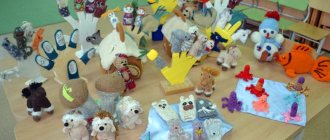The relevance of project activities in preschool institutions
Olga Danilenko
The relevance of project activities in preschool institutions
Nowadays in the pedagogical environment and in particular in preschool , a lot of attention is paid to design - pedagogical and children's. And for many teachers it is not entirely clear why design is needed in kindergartens . In this article I will try to explain and reveal the relevance of projects in working with children . The desire to observe and experiment, to independently seek new information about the world are the most important features of normal child behavior. Research and search activity is the natural state of a child. Children's need to search is biologically determined. Every healthy child is a little explorer from birth. He is determined to understand the world, he wants to get to know it as best as possible. It is this internal desire for research that gives rise to exploratory behavior and creates the conditions for the child’s mental development to initially develop in the process of self-development. The project-based teaching method is innovative for preschool institutions. It is aimed at developing the child’s personality, his cognitive and creative abilities. Project activities, like no other, support children's cognitive initiative in kindergarten and family settings. This topic is very relevant for a number of reasons .
Firstly, it helps the child gain early social positive experience in realizing his own plans. If what is most significant for a child is also of interest to other people, he finds himself in a situation of social acceptance, which stimulates his personal growth and self-realization.
Secondly, the ever-increasing dynamism within social relationships requires the search for new, non-standard actions in a variety of circumstances. Non-standard actions are based on originality of thinking. Thirdly, project activities help to go beyond the boundaries of culture (cognitive initiative)
culturally - in an adequate way.
It is project activity that allows not only to support children’s initiative, but also to formalize it in the form of a culturally significant product. Also, the topic of the project method is relevant for a number of reasons :
- federal state requirements (FSES)
to the structure of the basic general education program
of preschool education, they say that the program of a preschool educational institution should be built taking into account the principle of integration of the educational field in accordance with age capabilities and the specifics of educational fields.
— a person must, as early as possible, gain positive social experience in realizing his own plans.
— the ever-increasing dynamism of economic and social relations requires the search for new, non-standard actions in a variety of circumstances. Non-standard actions are based on originality of thinking.
Project activities of both teachers and preschoolers significantly change interpersonal relationships between peers and between adults and children. All participants in project activities gain experience in productive interaction, the ability to hear others and express their attitude to various aspects of reality. A new round of interest in the project as a way of organizing life activities is explained by its potential integrativity, compliance with developmental education technology, and ensuring children’s activity in the educational process. What is the modernization of education, in particular preschool ? According to T. A. Danilina (a well-known scientist in the field of psychology and pedagogy, pedagogical design arises in response to the social order for education and is carried out on the basis of pedagogical foresight and forecasting, serves as the process and result of the development of a scientifically based model of the rational characteristics of specific socio-pedagogical objects or their states in terms of solving certain social and pedagogical problems. Pedagogical design can become a way to develop the ability to exist in a field of uncertainty, a space that requires development. A modern teacher must have the knowledge and skills of pedagogical design and organization of project activities aimed at transforming the future in the field of education and education of preschoolers ... Thus, using in our work pedagogical design , and in working with preschoolers , the methodology of working with children to organize project activities project-based learning technology )
, we implement a personality-oriented and developmental approach to training and education.
Project activities allow us to :
1. Increase the professional level of teachers and the degree of their involvement in activities , make the team more united;
2. Form professional interaction between teachers and preschool children, which is based on the subjective attitude of the teacher to the child, an individual approach, taking into account the child’s zone of proximal development, a motivational approach, a friendly attitude towards the child, develop a system of productive interaction between participants in the educational process (children are involved in the project parents communicate with each other and with the teacher, and during pedagogical design all participants in the educational space of the kindergarten communicate with each other), as well as the scientific principles of constructing the basic general education program are implemented and the integrative qualities of the child are developed, which are the final results of the children’s mastery of the educational program.
The project-based teaching method promotes the development of independent thinking, helping the child to build confidence in himself and his own capabilities. It provides for a system of education in which children acquire knowledge and master skills in the process of completing a system of planned practical tasks. This is learning through search and cognitive activity , which is aimed at the result that is obtained when solving a problem. project method allows you to raise an independent and responsible personality, develop the child’s creative and mental abilities, and also promotes the development of determination, perseverance, teaches you to overcome problems that arise along the way, and most importantly, the ability to communicate with peers and adults, increases the child’s authority before peers and his own self-esteem . At the heart of every project lies some kind of problem. After all, the themes of the projects are born precisely from the interests of children
project method was reflected in the ideas of domestic scientists of the 20s: B.V. Ignatiev, V.N. Shulgin, N.K. Krupskaya. And recently, the theoretical foundations for the design of individual educational systems and technologies have been actively developed in scientific and pedagogical literature (V. S. Bezrukov, V. P. Bespalko, V. I. Zvyaginsky)
.As an option for an integrated method of teaching
preschoolers, a number of scientists consider project activities , such as T. A. Danilina, M. B. Zuikova, L. S. Kiseleva, T. S. Lagoda, etc.
The use of the project method in preschool education makes it possible to significantly increase children's independent activity. project method becomes a way of organizing the pedagogical process, based on the interaction of the teacher, parents and pupils with each other and the environment, and also makes the educational system of preschool institutions more open to the active participation of parents. Consequently, the project method is relevant not only for kindergarten, but also for society and the family as a whole.
Summary
The promise of the project method in the preschool educational system is that it provides the opportunity to develop observation and analysis of phenomena, comparison, generalization and the ability to draw conclusions, creative thinking, logic of knowledge, inquisitiveness of mind, joint cognitive-search and research activities , communication and reflective skills and much more that are components of a successful personality.
A promising method in the DOE system is that it allows the development of observation and analysis of phenomena, comparisons, generalizations, and skills to draw conclusions, creative thinking, logic of knowledge, inquisitive mind, a joint educational and research activities, communication and reflective skills, and much more, what are the ingredients of a successful personality.
Literature
1. Borovleva A. V. Project method - as a means of improving the quality of education / A. V. Borovleva // Preschool educational institution management. - 2006. - No. 7.
. Veraksa N. E. Project activities of preschoolers . Manual / N. E. Veraksa, A. N. Veraksa. - M.: Mozaika-Sintez, 2008. - 112 p.
. Vinogradova N. A. Educational projects in kindergarten . Manual / N. A. Vinogradova, E. P. Pankova. - M.: Iris-Press, 2008. - 208 p.
. Evdokimova E. S. Design technology in preschool educational institutions / E. S. Evdokimova. - M.: TC Sfera, 2006. - 64 p.
Danilina T. A., Zuikova M. B., Kiseleva L. S., Lagoda T. S., Project method in the activities of preschool institutions : A manual for managers and practitioners of preschool educational institutions
Report on the topic: “Project activity as a modern educational technology in preschool educational institutions”
The teacher’s first step in working on a project is choosing a topic. In younger groups, the choice of project is made by the teacher, based on the interests of the children or diagnostic data. In groups of senior preschool age, the choice of project topic can be made by both the teacher and the children, in accordance with their desires and level of development. Children are participants in planning, their questions, ideas, proposals and life experiences are important criteria for selecting the content of the project. The second step is thematic planning on the selected problem, which takes into account all types of children's activities: play, cognitive-practical, artistic-speech, labor, communication, etc.
At the stage of developing the content of classes, games, walks, observations and other activities related to the theme of the project, educators pay special attention to organizing the environment in groups and in the preschool institution as a whole. The environment should be a backdrop for search activities and develop curiosity in preschoolers. When the basic conditions for working on the project have been prepared (planning, environment), the joint work of the teacher and children begins.
The implementation of any project in a preschool educational institution can be divided into certain stages:
Stage 1 – goal setting:
The teacher brings the problem up for discussion with the children. As a result of a joint discussion, a hypothesis is put forward, which the teacher invites the children to confirm in the process of search activity.
Stage 2 – development of a joint action plan to achieve the goal.
At this stage, a general discussion is held. Using the “three questions” model, the teacher, together with the children, draws up a plan for cognitive activity. It is important here that the teacher shows patience, respect for the point of view of each child, and tact in relation to ridiculous statements. For children of primary preschool age, the teacher can use hints and leading questions; older preschoolers need to be given more independence. The solution can be various activities: reading books, encyclopedias, contacting parents, specialists, conducting experiments, thematic excursions. The proposals received may be an addition or change to the teacher’s already prepared plan.
It is important that the teacher is able to show flexibility in planning and subordinate his plan to the interests and opinions of the children.
the 3rd stage begins - the practical part.
The implementation of projects occurs through various types of activities (creative, experimental, productive). The teacher’s task at this stage is to create conditions in the group for the implementation of children’s plans. The environment around the child should be unfinished, unfinished, so that he can think out, try, guess. Research activity at this stage is activated through problematic discussion, which helps to discover new problems, the use of comparison and contrast operations, the problematic presentation of information by the teacher, and the organization of experiments.



